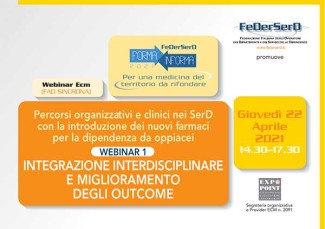Interdisciplinary integration and improvement of outcomes

Webinar: Organizational and clinical pathways in SerD with the introduction of new opioid addiction drugs
In opioid use disorder, agonist drug treatment has always played a central role in the coupling and therapy of the heroin patient. Far from wanting to support a unique role of the drug in the management of these complex patients, it is undeniable that the historical turning point of having real prospects of outcome, occurred when Dole and Nyswander published their work on the treatment of heroin patients with methadone hydrochloride; although, as stated by the two pioneers of treatment and clinical evidence - as well as neuroimaging techniques compared to addiction neurobiology, psychotherapeutic intervention is an essential element for the reworking and correction of drug-related representations of the self. In relatively recent times, the availability of competitive drugs for this disorder has gradually increased, drugs that will increase again in the short term with the arrival of new formulations. If, for a long time, the choice of an agonist treatment could only fall on the only drug available: methadone hydrochloride, now, and even more in the short term, the choice expands and expands on drugs differentiated from each other for: total or partial agonist action, duration of action, antagonistic effect on receptors, greater or lesser presence of unwanted side effects , greater or lesser interference with other drugs. This wider repertoire of drugs calls the individual Doctor to a greater capacity for therapeutic evaluation in comparison to the past, having the possibility to make a more precise choice with respect to the characteristics and needs, not only health, of the patient. At the same time, the Services are called to express a further ability both to rework their internal organization and to integrate with other structures, as in the case of Surgery for the management of drugs that provide for subcutaneous implantation. The webinar presented, the first of 3 closely related events, aims to sum up current pharmacological opportunities and the imminent future, as well as offering insights on the possible organizational repercussions within the Service and on interdisciplinary integration with other specialist branches, also with a view to creating differentiated settings that allow not only to provide more therapeutic options to the types of patients already in charge , but may also represent an organizational updating initiative of SerDs aimed at reaching types of users who typically tend not to turn to our Services. The webinar scheduled for June 10th will present the experiences of our services and will start an international comparison. On 23 September, we will focus on an initial assessment of the strengths and weaknesses of the new formulations, starting with patient impressions and suggestions.